Are You Listening? 25 Australian History and Genealogy Podcasts
Hands up how many of you listen to podcasts? Hmm, not enough of you. Before I get into that, let me start right at the very beginning by giving you the definition of podcast.
In simple terms, a podcast is a digital medium consisting of audio episodes that relate to a specific theme. The hosts of a podcast are referred to as “podcasters.”
So in essence it’s an audio recording that you can listen to on your computer, iPad, or phone. There are literally hundreds of thousands of podcasts available to listen to, on just about any topic that you can think of – just browse Audible to get an idea. They can be fun and entertaining, they can be horrifying, or they can be educational. Podcasts are great to listen to while you’re travelling.
Anyway today I just want to highlight a few Australian history and genealogy-related ones for you. Please note it takes a LOT of work and dedication to create a podcast, and as you’ll see some of those listed below are not currently active, but I’ve included them as you can still listen to the past episodes.
—-
AdeLOL – Adelaide & SA’s Hilarious History Podcast
https://adelol.podbean.com/
Stories of South Australia and Adelaide’s unique, and often hilarious, past.
Australian Ancestry Podcast
https://australianancestrypodcast.podbean.com/
The Australian Ancestry Podcast helps you make the most of your uniquely Australian family history research by providing insights into how to perform your research in Australia, overview of historical trends in Australian migration & settlement and interviews with leading Australian researchers.
Aussie History Podcast
https://player.fm/series/aussie-history-podcast
The Aussie History Podcast, (also known as the Aussie Waves Podcast) tells Australian history though the lens of all those peoples who have made the journey from other lands to call Australia home.
Australian Histories Podcast
https://www.australianhistoriespodcast.com.au/
The Australian Histories Podcast aims to take a fresh look at some of the brilliant stories from Australia’s past. Jenny is the host, and through her podcasts, she hopes to share with you an overview of various interesting episodes in Australian History, as well as some humour, interest and perhaps even a new perspective from those in your high school history textbooks!
Bookmark This Podcast
https://www.nla.gov.au/stories/podcast#
Bookmark This is a podcast from the National Library of Australia. Season one, Off Stage, explores the vibrant characters, milestone moments and cultural treasures found in the exhibition On Stage: Spotlight on Our Performing Arts. It delves into the untold stories of Australia theatre, dance, music and film. Season two, Bold Types is hosted by political reporter and author Amy Remekis. and it celebrates the pioneering women who took the world of journalism by storm, with each episode featuring contemporary female journalists reflecting on their experiences and those of their forebears.
Collected: Stories from the Australian War Memorial Podcast
https://player.fm/series/collected-stories-from-the-australian-war-memorial
Collected: Stories from the Australian War Memorial explores the artefacts that make up the museum of the Australian War Memorial and uncovers the stories that the public don’t always get to hear.
Convict Australia Podcast
https://podcasts.apple.com/au/podcast/convict-australia/id1550720354
A podcast about the convicts that were transported to Australia. Each episode offers a glimpse into life as a convict and a broader insight into the convict system. Presented by Jennifer Twemlow, author of ‘Convict Sydney: the real-life stories of 32 prisoners’.
Deviant Women Podcast
https://deviantwomenpodcast.com/
Alicia and Lauren are the hosts of Deviant Women. Every fortnight they discuss a different ‘deviant’ woman from history, fiction, mythology and the contemporary world: those who aren’t afraid to break the rules, to subvert the system, to explore, to seek and to challenge the status quo. While those covered in their podcast are not necessarily from Australia, Lauren and Alicia are, so for that reason I’ve included it here.
Downunder Genealogy Podcast
https://podcasts.apple.com/us/podcast/downunder-genealogy/
An Aussie genealogist who loves everything genealogy and wants to help and support others!
Goldfields Stories of Western Australia Podcast
https://player.fm/series/goldfields-stories-of-western-australia
History and stories of the Western Australian Goldfields written by local historian, Norma King (OAM) and Lorraine Kelly.
Forgotten Australia Podcast
https://forgottenaustralia.com/
From the desperate struggle against Spanish Flu in Sydney and the weekend Melbourne was ruled by anarchic mobs, to Brisbane’s most puzzling murder mystery and the Lord Howe Islander who tried to save passengers on the Titanic, each episode of Forgotten Australia brings you an incredible true story that you didn’t learn in history class.
Heaps Good History Podcast
https://player.fm/series/heaps-good-history
Exploring incredible true stories from South Australia’s past. A podcast brought to you by The Advertiser, in Adelaide.
The History Detective Podcast
https://historydetectivepodcast.com/
This began during the Pandemic, though the planning starte earlier. The site now has more than 35 episodes that look at different aspects of Australian History, including lesser known women from history and many stories about First Nations History.
History Lab Podcast
https://historylab.net/
History Lab is Australia’s first investigative history podcast. And they’ve got some good stories to tell. But they are interested in much more than just the story. Instead of an academic or other expert telling you what to think, History Lab wants to draw you in to the investigative process. It wants you to come along with us as we try to make sense of the traces the past leaves in the present.
The History Listen Podcast
https://www.abc.net.au/radionational/programs/the-history-listen
New and compelling stories from Australia and around the world, told by some of our most popular and trusted historians. Step inside a time machine for an immersive journey through history, where stories of people, places and events bring the past vividly into our present world.
The History of Australia Podcast
https://player.fm/series/the-history-of-australia-podcast
This is a narrative history podcast. It tells the story of Australia starting with the dawn of the Australian land mass, and moves forward through time until the year 2000.
I Was Only Doing My Job: Australia’s Military History Podcast
https://player.fm/series/i-was-only-doing-my-job-australias-military-history
“I Was Only Doing My Job” is a fortnightly (Bi-weekly) Australian Military History podcast hosted by Ross Manuel. Instead of focusing on maps and dates, each episode is devoted to chronicling Australia’s Military History through the individual stories of those who served; where they grew up, what they did, and invariably what happened to them.
Jennyalogy Podcast
http://jennyalogypodcast.blogspot.com/
Jenny Joyce talks about genealogy resources for Australia, New Zealand and the United Kingdom and Ireland – Society & Culture.
Kick to Kick Podcast: Australian Football Podcast 1858 to Modern Day
https://player.fm/series/kick-to-kick-2370489
An Australian Rules Football podcast, that looks at the history of the AFL/VFL. We start way back in 1897, and each episode will cover a different year. Enjoy hearing about the origin of the clubs, rivalries, players, finals systems, and much more. Note: the current episodes review recent games, but scroll back for the old, old games.
Look History in the Eye Podcast
https://prov.vic.gov.au/look-history-eye-podcast
This is the podcast Look history in the eye produced by Public Record Office Victoria. We interview people who delve into public archives and uncover interesting truths about Melbourne and Victoria’s past. Discover the back story to some iconic Melbourne and Victorian people and places, and download the archival record which inspired each episode.
The Portrait Detective Podcast
https://www.portraitdetective.com.au/podcast/
The Portrait Detective is a podcast series that dives into the collections of the State Library to discover the stories behind iconic portraits from 1817 to 1865. Join Margot Riley from State Library of NSW and Cassie Gilmartin (The Portrait Detective) as they journey back in time to discuss each portrait’s significance and how they can help you learn more about your own photographs in your family history collection.
Rum, Rebels and Ratbags Podcast
https://player.fm/series/rum-rebels-and-ratbags-108129
Humourist and historian David Hunt and ABC 702’s Dom Knight take on Australian history and uncover the characters, events and a cat that you won’t find in the regular history books. This is not history for the faint-hearted.
Tales from Rat City Podcast
https://talesfromratcity.com/
Join David and Tom as they uncover the strange, little known and down-right bizarre history of the wild days of early Ballarat (Victoria). Their podcast is dedicated to uncovering the forgotten stories of Ballarat’s dark and bizarre past from the 1850s through to the 1920s.
Uncovering Family History Podcast
https://podcasts.apple.com/us/podcast/uncovering-family-history/id1592802967
Victoria’s podcast is a weekly podcast sharing stories discovered through family history research – the highs, the lows, the exciting and even the mundane.
WW1 Digger History Podcast
https://open.spotify.com/show/1XYRrpuUEJS4wqvvvMT2Vw
Phil Mannell presents true accounts by soldiers of the Great War (World War 1 / WWI ). This is primary history as told by the soldiers themselves, mostly Australian diggers but possibly tommies, poilus, doughboys, kiwis or others, with additional commentary and definitions. It is memoirs and diaries of real men and women who served in the Great War, recounting the horrors of war, life behind the trenches and on leave in England, France and around the Mediterranean.
—-
So there’s lots of variety there. Australia history as well as some regional histories, military history, convicts, women’s history, as well as genealogy related ones too. So plenty to listen to, and learn more about Australian history and genealogy. Podcasts are just another tool you can use for your education … and they’re ALL FREE!!
The Stories of the 19 Crimes Convicts
19 Crimes. You’ve heard of the wine. Seen it in the bottle shops, and possibly even enjoyed a bottle (or two). And maybe even read my earlier blog posts about them.
So what is it you like about the 19 Crimes wine that you like?
Is it the corks (or lids for the bottles that are available in Australia), each which lists a transportable crime? Is it the wine itself? Or is it the convicts?
For me it was the convicts. But hey, I’m a genealogist, with a love of history and convicts, so OF COURSE I was going to love these!!
But, do you know the stories of those that feature on the 19 Crimes wine labels? No? They were real people, each who had their lives changed by being transported to Australia for their crime. So let me tell you a little of their stories.
——————————————————
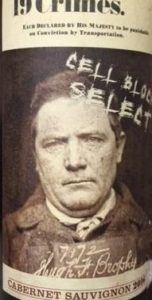 Hugh Brophy (1829-1919) (Cabernet Sauvignon)
Hugh Brophy (1829-1919) (Cabernet Sauvignon)
Crime: treason and felony
Sentence: 10 years
Ship & Departure date: 10 October 1867, Hougoumont
Sent to: Fremantle Prison, Fremantle, Western Australia
Hugh Brophy was a leading Fenian and staunch supporter of Irish independence. He was convicted for his part in a plot to overthrow the perceived tyranny of the British and was sentenced to penal servitude, however this changed to transportation for life to Australia.
Despite many of the Fenians having received long sentences in exile, there was a huge outcry in England, Ireland, and also in Western Australia about imprisoning and transporting them. So much so, that Queen Victoria decreed some of the Fenians should be pardoned. Instructions dated 26th March 1869 were sent from England, and granted 34 civilian Fenians the benefit of the royal clemency “without delay”. “They were assembled as soon as possible at Guildford where on 15 May 1869, they received their free pardons”. Hugh Brophy was one of them.
Hugh then went into partnership with fellow convict Joseph Noonan, establishing a highly successful bridge building and construction company. They won a number of contracts from the Catholic Church, the government, and private enterprise, and hired ticket-of-leave men to do stone cutting, carpentry and labouring. Eventually, Brophy left the partnership and went to Melbourne in 1872. Brophy died on 11th June 1919, and is buried at Melbourne General Cemetery.
——————————————————
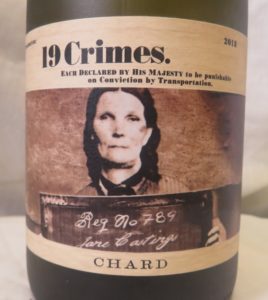 Jane Castings (c1813-1895) (Hard Chard)
Jane Castings (c1813-1895) (Hard Chard)
Crime: Knowingly receiving stolen goods
Sentence: 7 years
Ship & Departure date: 8 May 1846, Sea Queen
Sent to: Cascade Female Factory, Hobart, Van Diemen’s Land
Born in Leicester as Jane Pratt, Jane married Henry Castings, had 4 young children, and was employed as a housemaid, when in 1846 she was sentenced to 7 years transportation for “receiving cheese and bacon knowing the same to have been stolen”. Jane had long been ‘suspected’ as being a fagin, meaning she trained and paid a group of teenage boys to steal the goods that she requested, but worse was that she was the cause of six young boys being transported ‘beyond the seas’. You can read plenty more about Jane Castings here.
Jane served her 7 years, was granted her Certificate-of-Freedom, and in 1853 she married ex-convict David Hayes in Hobart and had several children. Jane is buried in the Swansea Cemetery, Tasmania.
——————————————————
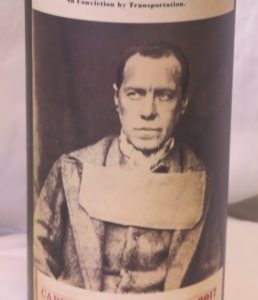 Michael Harrington (1825-1886) (Cabernet Sauvignon)
Michael Harrington (1825-1886) (Cabernet Sauvignon)
Crime: Irish rebel (Mutinous conduct and Desertion)
Sentence: Life (escaped)
Ship & Departure date: 10 October 1867, Hougoumont
Sent to: Fremantle Prison, Fremantle, Western Australia
Best known for orchestrating one of the most daring escapes from Australia. In 1876, Harrington, along with six others, braved a massive typhoon in just a tiny rowboat to board an American whaling ship in what is now remembered as the Catalpa Rescue. There’s a great article about this on the Smithsonian magazine site.
From the New York Times dated 14 February 1886, we learn that “Michael Harrington, the eldest of the six Fenian prisoners who were rescued from New South Wales by the American whaler Catalpa in 1876, died on Friday night of pneumonia at the residence of his brother-in-law, Edward Whelan, No. 111 East One Hundred and Eighth-street.”
——————————————————
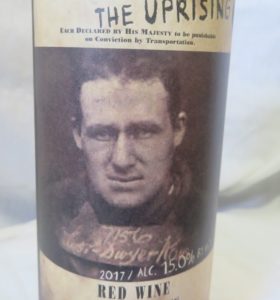 Cornelius Dwyer Kane (1839-1891) (Red Wine, The Uprising)
Cornelius Dwyer Kane (1839-1891) (Red Wine, The Uprising)
Crime: Treason
Sentence: 10 years
Ship & Departure date: 10 October 1867, Hougoumont
Sent to: Fremantle Prison, Fremantle, Western Australia
Cornelius Dwyer Kane (aka Keane), a law clerk from Skibbereen, County Cork, Ireland was convicted for treason and transported on the Hougoumont. Conditionally pardoned in 1871, he was forbidden from returning to Ireland, So he never reunited with his wife and children there.
He did however, settle in Queensland and became a civil servant.
Cornelius died in October 1891 and is said to be buried somewhere in an unmarked grave on the goldfields in north Queensland.
The Uprising label is said to be a tribute to the Rum Rebellion that took place in New South Wales in 1808.
——————————————————
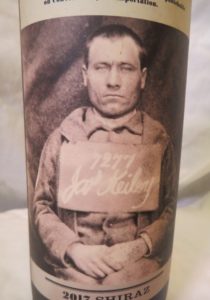 James Keiley (c1840-……. ) (Shiraz)
James Keiley (c1840-……. ) (Shiraz)
Crime: Treason, not informing of a mutiny
Sentence: Life
Ship & Departure date: 10 October 1867, Hougoumont
Sent to: Fremantle Prison, Fremantle, Western Australia
Born James Michael Keiley in Colligan, County Waterford, James was a member of the 53rd Regiment and stationed in Tipperary, Ireland. At the time soldiers were employed to evict the poor peasants, which no one could help but sympathise with. And as such, Fenian uprisings were happening all over Ireland.
Married with two young children, James was convicted of High Treason for creating skeleton keys to get into the armory, and taking 2000 rifles which he distributed to fellow members. However he and a number of others were caught before the riots there took place, and he was sentenced to transportation “for life”.
James also played a part in the “Catalpa Rescue”, which obviously didn’t go to plan, as he was left behind.
In 1905, after having served 38 years, James was granted a pardon by the King. There’s a great article on Trove about this here. Note: James’ surname is sometimes spelled Keily, Keilly, Kiely or Kieley.
——————————————————
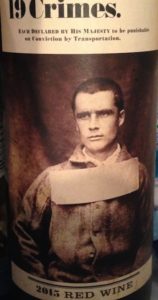 John Boyle O’Reilly (1844-1890) (Red Blend)
John Boyle O’Reilly (1844-1890) (Red Blend)
Crime: Irish rebel
Sentence: Sentenced to death, was later transported for 20 years instead (escaped after 2 years)
Ship & Departure date: 10 October 1867, Hougoumont
Sent to: Fremantle Prison, Fremantle, Western Australia
While in his teens, John O’Reilly lived with his aunt and uncle in Lancashire, and took up work on local newspaper the Preston Guardian, and in June 1861, he enrolled in the 11th Lancashire Rifle Volunteers, with which he received some military training.
On returning to Ireland in March, 1863, he enlisted with the 10th Hussars in Dublin. While O’Reilly was in the army he began to witness the treatment and oppression of his fellow citizens in Ireland, these events influenced his opinion on the army and he was determined to take action.
As a youth in Ireland, he was a member of the Irish Republican Brotherhood, or Fenians, for which he was transported to Western Australia.
Not wanting to face a lifetime in chains, in February 1869, O’Reilly absconded from his work party and met up with James Maguire, a local settler and together they rowed out into the Indian Ocean.
It took until the end of 1869 to make it to the United States, but once there he became a prominent spokesperson for the Irish community and culture, through his editorship of the Boston newspaper The Pilot, his prolific writing, and his lecture tours.
On 15 August 1872 John O’Reilly married Mary Murphy (1850-1897), a journalist who wrote for the ‘Young Crusader’ under the name of Agnes Smiley, and they had four daughters.
For more on John O’Reilly click here and here.
——————————————————
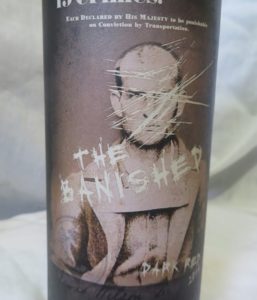 James Wilson (1836-1921) (Dark Red, The Banished)
James Wilson (1836-1921) (Dark Red, The Banished)
Crime: Irish rebel
Sentence: Sentenced to death, was later transported for Life instead (escaped)
Ship & Departure date: 10 October 1867, Hougoumont
Sent to: Fremantle Prison, Fremantle, Western Australia
Born James McNally in Newry, County Down, Ireland in 1836, he joined the British Army at the age of 17 (enlisting under a false name), before returning to Ireland where he became a Fenian in 1864 as he was disenchanted with the army and their treatment of people.
On 10 February 1866, he was arrested and along with other military Fenians was tried, found guilty of desertion and mutinous conduct, and sentenced to death. However, this sentence was later commuted to penal servitude for life, and they were transported to Western Australia. In October 1867, Wilson and sixty one other Fenians began the long sea voyage on board the Hougoumont to Australia.
In 1876, the American ship “Catalpa” sailed to Western Australia and rescued Wilson and five other Fenian prisoners, and over a period of 4 months, made it’s way to New York.
Wilson settled in Rhode Island, where he married and lived out the rest of his life. He died on 6 November 1921, and his remains are buried in the cemetery at St Mary’s Church in Pawtucket, Rhode Island. For more on James Wilson, click here.
——————————————————
So as you can see, they all have a story. They all had a life that was radically changed by being transported. And they are all part of Australia’s history, and I’m pleased that the are being remembered.
And just one last note, please be aware that this list is a work-in-progress. I know that more bottles have already been released, and I’m still working on identifying those, and will add them when I have. And as new bottles in the range are released, I’ll get those added to the list as well. Also if you have 19 Crimes bottles other than those listed above, please send me a photograph. I’m aware that different bottles are being released in different countries, so tracking them all is interesting, but I’ll keep trying.
William Cosgrove, Convict
My 3x great grandpa William Cosgrove is one of those people that you have some info on him from a certain date, but nothing beforehand, so he’s always been a mystery. I know he married in South Australia, had kids there and died there … but before that, nothing!!
However it was relatively recently that a cousin (thanks Judy), mentioned that she believed he was a convict.. So hence the research to prove or disprove this theory. I only have one direct convict on my line so far, so am eager to see if I have two (and it would be the first on my paternal line).
Let me start off by saying that there are several William Cosgrove’s who were convicts. The three I found were:
– William Cosgrove, transported on the ‘Mariner’ 1827
– William Cosgrove, transported on the ‘Royal Admiral’ 1830
– William Cosgrove, transported on the ‘Mangles’ 1840
What I know of ‘my’ William Cosgrove, age, occupation, and residence matches pretty closely with references to the 16 year old William Cosgrove, who was transported to New South Wales on the Royal Admiral in 1830.
As I don’t have a nice big long biography of William, or even an obituary giving all the amazing details throughout his life … it’s up to me to piece his life together from what I can find.
As a means to track it all, I have created a timeline and while I still have some gaps to fill, between the convict records, newspapers and gazettes it’s created a reasonable timeline already.
It is a work in progress, and there’s still much research to be done, and at this stage I don’t feel that I can yet say 100% for sure that William Cosgrove, convict is one of ‘my’ convicts. But at this stage I would call it “quite plausible”. Time will tell, and I’m still crossing my fingers.
***********
Timeline for William Cosgrove
- born 1814 – native place London on Certificate of Freedom
- born 1815 – native place London passenger list Royal Admiral
- 27 May 1830 – (aged 16) convicted at Old Bailey, London for stealing a plane, sentenced to 7 years transportation
- 18 Jun 1830 – transported to the prison hulk ‘Leviathan’ at Portsmouth
- 1 Jul 1830 – transported to New South Wales on ‘Royal Admiral’ .. age 16, Educ R, Relig P, Sing, native London, Plaisterer 3/2 yrs, stealing plane, where & when tried: Newgate, 29 May 1830, 7 yrs, height 5’1 ½”, ruddy, hair brown, eyes light hazel, Dept of Public Works, tattoos
- 8 Nov 1830 – Arrived New South Wales
- between 1 Jan and 31 Mar 1832 – Cosgrove William, plasterer and labourer assigned to Joseph Morley, Sydney
- 7 Apr 1834 – Cosgrove William, 20 absconded … plasterer, 5 feet 12, ruddy comp. brown hair, light hazel eyes, W outside right arm, cupid, woman, BD and sun on left, WC, heart, and wreath on upper right arm, from Joseph Morley, Sydney
- 16 Apr 1834 – (in the week before) RUNAWAYS APPREHENDED, … from Jos. Morley
- 19 Feb 1837 – (before this date) William Cosgrove 23, absconded (again) …London, plasterer, 5 feet 02 inch, ruddy comp , brown hair, light hazel eyes, outside of right arm, cupid woman B D and sun on left, W C heart and wreath upper right arm. from Joseph Morley
- 3 Aug 1837 – William Cosgrove – obtained Certificate of Freedom (SRNSW) … native place London, occupation Plasterer, year of birth 1814, height 5’4 ½”, ruddy, hair brown, eyes grey, & a bunch of tattoos
- 6 Apr 1842 – Newspaper report of a William Cosgrove employed by a plasterer – Sydney. Fined for smashing windows!
- June 1847 – unclaimed letter for William Cosgrove, plasterer (maybe at Parramatta)
- Oct 1847 – unclaimed letter for William Cosgrove, at Cassis (between Newcastle & Dubbo
(no identifier like “plasterer” this time – so may not be the same William Cosgrove) - 14 Dec 1853 – William Cosgrove plasterer, witness in a court case – reported in a Goulburn paper
- 10 Feb 1856 – married Anne McGrath Adelaide
- 1857-1872 had 7 children with Anne/Hannah McGrath in South Australia. First child Den(n)is, was a plasterer
- 27 Oct 1873 – a William Cosgrove, Plasterer of New Glenelg died of pneumonia, signature on death certificate is John Cosgrove, or New Glenelg (maybe a brother, or son who would have been 16). Age given as 57, suggesting a birth year 1815/16 – a 1 or 2 yr discrepancy from what is derived from trial/gazette records (this is not uncommon)
So there’s more work to do, but that’s what research is all about. Finding the pieces, and putting them together.
21 Facts About the First Fleet
Did you know that approximately 20% of Australians descend from convicts … yes, true! Having a convict in the family has become a badge of honour for many, and having a First Fleeter even more so.
And while the term ‘convict’ tends to mean ‘criminal’, so many of the 162,000 who were transported to Australia weren’t actually ‘bad’. In fact, many were just trying to survive.
So just how much do you know of your Australian convict history? In particular the First Fleet? Here’s some intriguing facts that you probably didn’t know.
- Why send convicts to Australia?
Britain had shipped about 52,000 convicts to America between 1717 and 1775 before they started sending them to Australia. And it was because of the American Revolution in 1776 that Britain started sending their criminals to Australia. - When and where did it leave from and arrive?
The fleet left Portsmouth, in Hampshire, England on 13 May 1787, and arrived at Botany Bay, New South Wales, Australia between 18-20 January 1788 - How many ships in the first fleet?
The whole fleet consisted of 11 ships. 6 convict ships, 2 naval ships and 3 ships with supplies - What are the names of the ships in the first fleet?
H.M.S. Sirius, Charlotte, Alexander, Scarborough, Lady Penrhyn, Friendship, H.M.S. Supply, Prince of Wales, Golden Grove, Fishburn and Borrowdale - Who was the captain of the first fleet?
Captain Arthur Phillip - What about Port Jackson?
The fleet arrived at Botany Bay but as that place was deemed unsuitable as a settlement due to the lack of fresh water, the fleet sailed on to Port Jackson (Sydney Cove), New South Wales arriving on 26 January 1788 - What’s so special about the date 26 January?
26 January marks the anniversary of the 1788 arrival of the First Fleet of British ships at Port Jackson, New South Wales and the raising of the British flag at Sydney Cove by Governor Arthur Phillip, which signifies the beginning of European settlement in Australia. - How long did the first fleet voyage take?
The voyage took 259 days (8 months and 14 days) - Did the fleet stop anywhere along the way?
They sure did. They stopped at Tenerife (Canary Islands), Rio de Janeiro (Brazil) and Cape Town (South Africa) on the way to stock up on food and supplies. - How many convicts were on the first fleet?**
When the ships left England there was a total of 1420 people onboard: Officials and passengers 15, Crew 323, Marines 247, Marines wives and children 46, Male convicts 582, Female convicts 193, Convicts’ children 14 - How many convicts arrived in New South Wales?**
When the ships arrived there was a total of 1373, due to some deaths on the voyage: Officials and passengers: 14, Crew: 306, Marines: 245, Marines wives and children: 54, Male convicts: 543, Female convicts: 189, Convicts’ children: 22** - How big were the first fleet ships?
Alexander, weighing in at 452 tons, 114ft (34.7m) long and 31ft (9.4m) wide the Alexander was the largest ship in the fleet. To put it in perspective the ship was just a little larger than the size of a standard tennis court. - What were the crimes of the convicts?
The most common were: Petty theft, Burglary or housebreaking, Highway robbery, Stealing clothing, Stealing animals, Military offences, Prostitution, Crimes of deception, and Political protest. - Who was the youngest female convict?
Elizabeth Hayward/Haywood was aboard the Lady Penrhyn and was the youngest female convict on the First Fleet. She was 13 when sentenced, and 14 when the first fleet sailed. Her crime was stealing a linen gown and a silk bonnet. She was an apprentice clog maker before she was transported. - And the youngest male convict is …
John Hudson a ‘sometimes’ chimney sweeper, at 9 years old, and the youngest First Fleet convict at the time of sentencing, was tried at the Old Bailey in London in December 1783, to seven years transportation for breaking and entering a dwelling house. He was 13/14 when he was transported. - What nationality were the convicts?
Most were English, Irish or Scottish, but there were also some African, American and French convicts on the first fleet. - Religion and the first fleet …
It’s well known that religion came to Australia with the first fleet. A reasonable portion of the convicts identifying themselves as Christian. - And the first church service held on Australian soil was …
The fleet arrived at Port Jackson on January 26th, on the following Sunday, February 3rd the first church service was held for the officers, marines and convicts on Australian soil. The service was led by the colony’s Chaplain, the Reverend Richard Johnson, on a grassy hill under a tree - What were some of the items brought on the storeships?
This is a small sampling of the stores: 6 butcher’s knives, 10,000 bricks, 18 coils of whale line, harness for 6 horses, 8 dozen pounds of sewing twine, 10 smith’s bellows, 7 dozen razors, 127 combs, 1 portable canvas house for Gov. Phillip), 589 women’s petticoats, 250 women’s handkerchiefs, 10 pairs of handcuffs, mill spindles, 10 forges, 700 spades, 700 west india hoes, 747,000 nails, 40 wheel barrows, 30 grindstones, and even a printing press. They also brought seeds, and many fruit trees. - What animals came out with the first fleet?
18 turkeys, 29 geese, 35 ducks, 122 fowls, 87 chickens, kittens, puppies, 4 mares, 2 stallions, 4 cows, 1 bull, 44 sheep, 19 goats, 32 hogs, 5 rabbits, as well as Governor Phillips’ greyhounds, and Rev. Johnson’s cats - The 26th of January hasn’t always been called “Australia Day”, so what was it known as?
It was originally known as “First Landing Day” or “Foundation Day”, and there’s evidence of these celebrations taking place that date back to the early 1800s. However it wasn’t until 30 years after the landing, that the first “official” celebrations were held in 1818. But as each Australian state was it’s own colony, and politics being politics, it took until 1935 to settle on a uniform date for all states to agree on, and named as Australia Day.
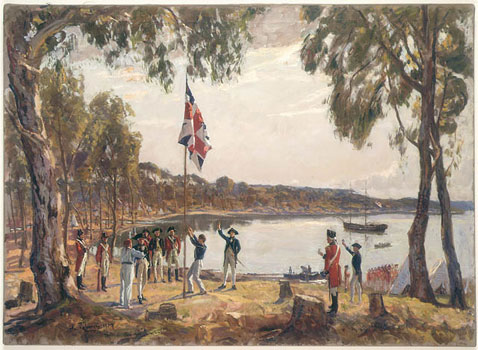
The Founding of Australia, 26 January 1788, by Captain Arthur Phillip R.N., Sydney Cove. [Original oil sketch (1937) by Algernon Talmadge R.A. ML1222]
– Here’s a map of the journey taken by the First Fleet.
– Search for the names of the convicts on the First Fleet here
As a side note, if you find a convict if your family history, you have Australian royalty (as it’s known). However if you can lay claim to being descended from a First Fleet convict, then you have ‘true’ Australian royalty.
**[Please Note: the numbers vary depending on the report. But there were over 710, and can be up to 780]




